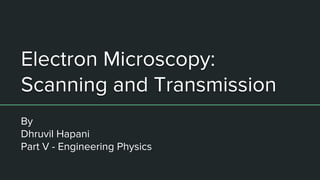
Scanning and Transmission Electron Microscopy
- 1. Electron Microscopy: Scanning and Transmission By Dhruvil Hapani Part V - Engineering Physics
- 2. History ● In the early 1930’s, there was a scientific desire to see the fine details of the interior structures of organic cells (nucleus, mitochondria etc). ● Light microscopes being used were limited by the physics of light, the best ones able to produce 1000X magnification and a resolution of 0.2 micrometers. ● The transmission electron microscope was the first type of electron microscope to be developed. ● It was developed by Max Knoll and Ernst Ruska in Germany in 1931.
- 4. ● Electron microscopes are scientific instruments that use a beam of energetic electron to examine objects on a very fine scale ● It yields information about the topography, morphology, composition, and crystallographic information of the specimen ● It can achieve magnification upto 10,000,000x and resolution of upto 50 pm ● They use a focused beam of electrons instead of light for analysing the specimen Introduction
- 5. 1. Topography : The surface features of an object, it’s texture; direct relation between these features and material properties 2. Morphology: The shape and size of the particles making up the object 3. Composition: The elements and compounds that the object is composed of and the relative amounts of them 4. Crystallographic information : How the atoms are arranged in the object Characteristics observed
- 6. Electron gun ● The first and basic part of the microscopes is the source of electrons. It is usually a V-shaped filament made of LaB6 or W that is wreathed with Wehenlt electrode. ● Due to negative potential of the electrode, the electrons are emitted from a small area of the filament (point source) Condenser lens ● This lens converges the cone of the electron beam to a spot below it. ● It formulates the beam shape and size Components of SEM
- 7. Scanning coils ● After the beam is focused, scanning coils are are used to scan the electron beam across the specimen surface ● Two scanning coils produce deflections in horizontal and vertical directions ● This allows it to scan in a raster fashion over a rectangular area of the sample surface Objective lens ● This is the last lens in the series that creates the electron beam that scans the specimen ● The lens focuses the scanning beam to a very small spot on the specimen Components of SEM
- 8. ● Secondary emissions ● X-ray emission ● Backscattering ● Auger emission ● Visible light ● Transmission ● Diffraction ● Absorption ● Heat Specimen Interactions
- 9. Secondary electrons They are produced when an incident electron excited an electron in the sample by losing most of its energy. The excited electron moves towards the surface of the sample undergoing collisions until it reaches the surface, where it can escape if it still has sufficient energy. Because of collision losses, only secondary electrons that are very near the surface ( < 10 nm) can exit the sample and be examined. This feature helps to produce very fine topographical images and examine the surface features of our sample Specimen Interactions
- 10. Backscattered electrons These electrons consist of high-energy electrons originating in the electron beam, that are reflected out of the specimen interaction volume. The production of backscattered electrons varies directly with atomic number. This differing production rates causes higher atomic number elements to appear brighter than lower atomic number elements. This interaction is utilized to differentiate parts of the specimen that have different average atomic number. Specimen Interactions
- 11. Inelastic interactions These interactions produces the fingerprint of each element. 1. X-Ray emission 2. Auger emission Specimen Interactions
- 12. ● TEM is a technique in which a beam of electrons is transmitted through a specimen to form an image. The specimen is most often an ultrathin section less than 100 nm thick. ● An image is formed from the interaction of the electrons with the sample as the beam passes through the specimen. ● The image is then magnified and focused onto an imaging device, a layer of photographic film or some sensor. ● It is a major analytical method in the physical, chemical and biological sciences. Transmission electron microscopy
- 13. Magnetic lensing Glass lenses, of course would impede electrons. Electron microscope lenses are electromagnetic converging lenses. A tightly wound copper wire forms a solenoid. Electrons move through the centre hole in helical path depending on the lens current. Condenser lens This lens gather the electrons and focus them onto the specimen to illuminate only the area being examined. Components of TEM
- 14. Objective lens The Objective lens is used primarily to focus and initially magnify the image. An objective aperture is used to enhance specimen contrast. Intermediate lens Intermediate lenses magnify the image coming from the objective lens. Finally, projector lenses further magnify the image coming from the intermediate lens and projects it on to the phosphorescent screen. Screen The final image is viewed by projection onto a phosphorescent screen which gives off photons when irradiated by the electron beam. Components of TEM
- 15. Transmitted beam When incident electrons are transmitted through the thin specimen without any interaction occurring inside, then the beam of electrons is called transmitted. The transmission of unscattered electrons is inversely proportional to the specimen thickness. Areas of specimen that are thicker will appear darker, while thinner areas will appear lighter Specimen Interactions
- 16. Diffracted beam Some electrons are scattered by the atoms in the specimen in an elastic fashion (no loss of energy). These scattered electrons are then transmitted through the remaining portion of the specimen. All electrons follow Bragg’s law and thus are scattered according to n λ=2 d sin(θ) These electrons yield information about the orientation, atomic arrangements and phases present in the area being examined. Specimen Interactions
- 18. Thank you for your time!